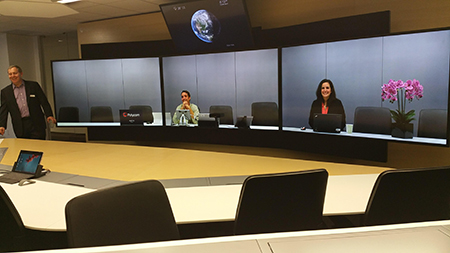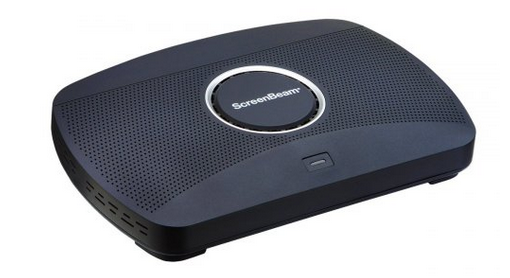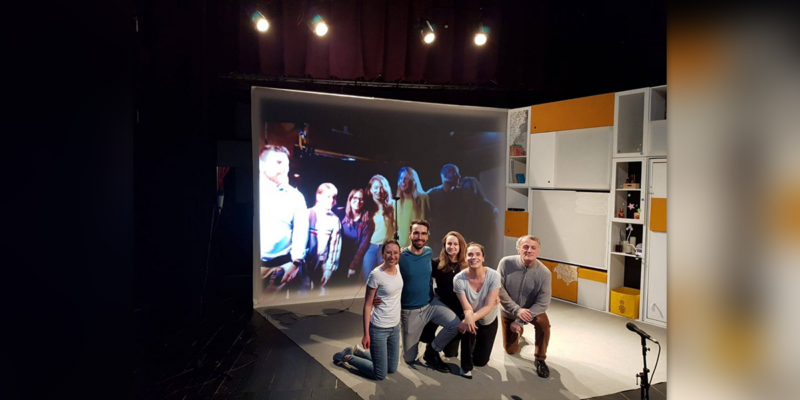An Evening with Polycom — On Software and Experience
 Last week my fellow consultants and I were invited to an event at conferencing stalwart Polycom’s New York City experience center. It’s a pretty and shiny new spot at One Penn Plaza, with a nice river view outside and their technological toys inside. For me the more interesting part isn’t the specifics of a single manufacturer’s offering but a broader overview of how manufacturers — especially traditional hardware manufacturers like Polycom — are positioning themselves in today’s increasingly software-based world. If one can deploy a simple room system utilizing Hangouts, Lync, WebEx, GotoMeeting or similar at a price tag under five thousand dollars (This is possible. I’ll leave the actual design as an exercise for the reader.), then those who once sold videoconferencing appliances for tens of thousands of dollars certainly need to pivot towards a more modern, more scalable and less costly set of solutions.
Last week my fellow consultants and I were invited to an event at conferencing stalwart Polycom’s New York City experience center. It’s a pretty and shiny new spot at One Penn Plaza, with a nice river view outside and their technological toys inside. For me the more interesting part isn’t the specifics of a single manufacturer’s offering but a broader overview of how manufacturers — especially traditional hardware manufacturers like Polycom — are positioning themselves in today’s increasingly software-based world. If one can deploy a simple room system utilizing Hangouts, Lync, WebEx, GotoMeeting or similar at a price tag under five thousand dollars (This is possible. I’ll leave the actual design as an exercise for the reader.), then those who once sold videoconferencing appliances for tens of thousands of dollars certainly need to pivot towards a more modern, more scalable and less costly set of solutions.
Save a few PowerPoint slides on the back-end stuff and general system topology, there was very little talk of hardware. A few years back, the first thing I looked at in a spec sheet was a back-plane photo; today’s world of streaming, USB video and various forms of software-based manipulation make the standard “picture of the back” less interesting and, ultimately, less informative. What they did talk about was software.
This isn’t surprising; years ago, Polycom started to rebrand itself as a software company. (Side note: The other giant in the hardware VTC segment, Cisco, also considers itself a software company. Yes, most of what it sells are physical boxes in switches, routers and the like, but the magic — what makes Cisco what it is — is in its OS and implementation of various tools and protocols. In the end, everything is software — even things that look like hardware. End of side note). Overall, they discussed three broad pillars in what they see as the “workplace of the future”: workspace, workflow and experience (the latter involving both technical staff and end-users — this is an important shift in focus which we all need to make). Years ago, simply being able to share video content was something noteworthy and special. In today’s world, many users have — at least broadly speaking — video sharing and communication tools literally in their pockets. Enterprise-grade tools need to be as easy and intuitive to use as their consumer counterparts.
The handful of live demonstrations scheduled for the event all focused on software-based tricks and implementations. Small gadget-type items included the following:
- A face-recognition tool for their cameras which will pan and zoom to include only those parts of the room containing human faces. If someone wanders out, it will zoom in a bit to only cover those remaining. Additionally, it can count faces to provide analytics for meeting attendance.
- An “audio-fence” algorithm which will mute audio from a talker as they move away from a predetermined location. The example they showed was at the reception desk in the very experience center at which the event was held. If the receptionist moves back from her desk to, for example, sign for a deliver her audio will mute. This is a neat way to reduce unwanted side-chatter. I’ll note that it didn’t seem perfectly seamless — her voice did cut in briefly in the “away” position — but it is a neat idea.
- Smart muting to shut down remote microphones if human speech isn’t detected. For this demo, the talker at the far-end was eating a bag of chips. When he stopped talking, his mic muted even though there was still (so far as any of us could tell) noise in the room from the chips bag. I, for one, appreciate Polycom’s employees taking the personal risk of increased cholesterol in service of a product demo.
None of these are quite major enough to force a decision of one system over another, but they’re all nice add-ons and the kind of thing which can possibly tilt a close decision one way or another, depending on a client’s personal preferences and priorities.
Another demo, and the one in which they drew a direct comparison to competitors, was integration with Microsoft Lync. Lync has been an increasingly major player in the professional AV space for several years now, and integration with room systems and infrastructure has become increasingly smooth and seamless. Overall, I find direct comparisons to competing platforms slightly off-putting; the cynic in me is certain that anyone can find the one thing their system does better than the competition and highlight that. What made it interesting is that the aspect discussed was not a standalone special ability but tighter integration with the Microsoft environment. This says something about where the current state of the industry is; not many years ago it would be unthinkable for a manufacturer of room systems to focus on integration with desktop infrastructures. Now, it’s a centerpiece. As an AV designer, it also serves as a reminder that a client’s larger ecosystem is more important than ever. Does your client use Lync? This would be a great option. Do they use Google Apps? You’re best off looking elsewhere, as Google’s choice of a competing vendor’s platform to handle the “Hangouts” video chat feature leaves Polycom unable to offer the same tight integration.
The presentation and most of what we spoke about focused on the above kind of factor. Interoperability. Scalability. Even mention of various pricing plans which can simplify and increase the focus on operational expenditures as opposed to capital expenditure. In an increasingly IT-based world, this is more the direction in which we will have to look. They spoke of simplifying what has traditionally been a bit of a confusing and opaque price structure, about scalability, about interoperability.
It is telling that the very last demo — really an afterthought after the event had “officially” ended — was a demonstration of an immersive telepresence room. It is, no doubt, pretty. And it’s impressive. Sadly, it doesn’t fit into today’s world as well as it once did. It’s gone from flagship product to a very niche item, albeit a fun one on which to end a visit.




